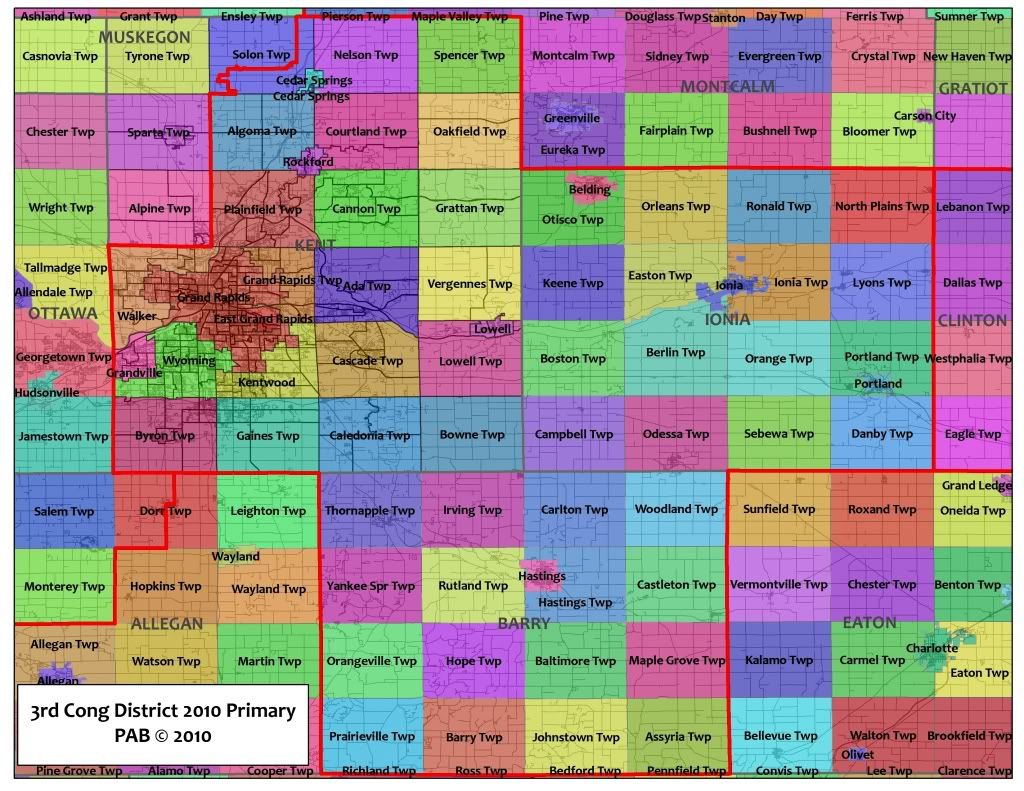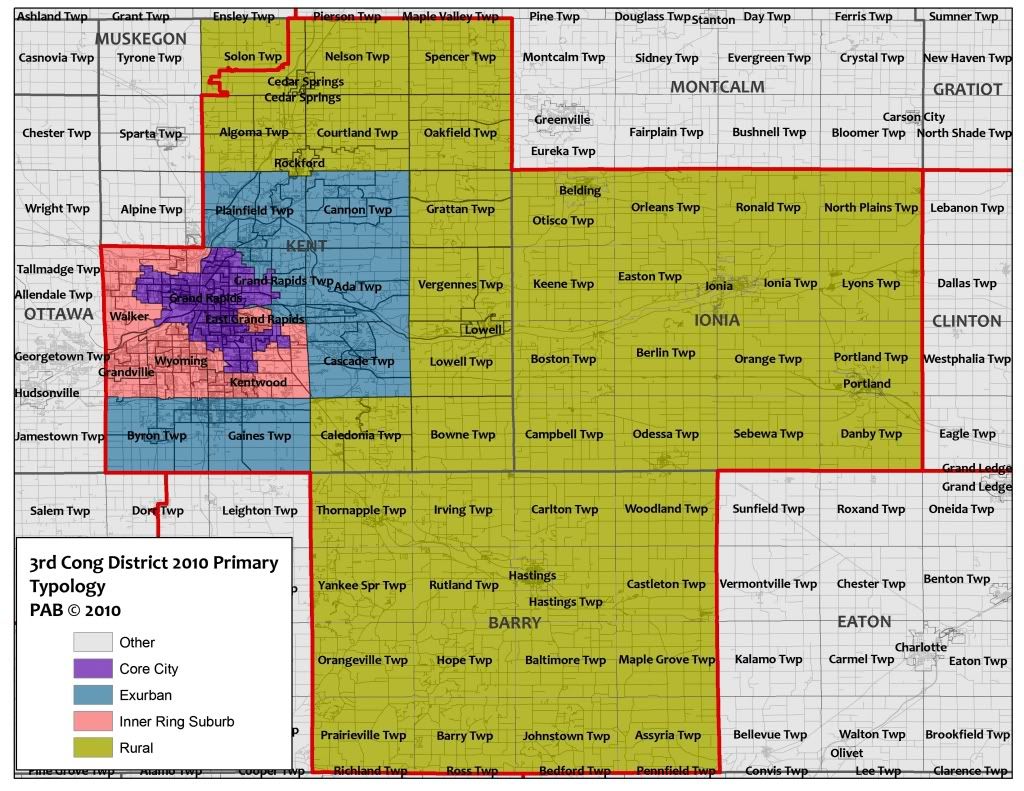(cross-posted on WMR-pb)
Introduction
With just over three weeks before the August 3 primary, Republican and Democratic campaigns are starting to take a look at who might be coming to the polls. Voter turnout in August tends to be rather apathetic, given that many folks are out of town or find the choices on the ballot to be unappealing. However, the 2010 Republican and Democratic primaries have a host of interesting candidates to choose from, although none as interesting as in the 3rd Congressional District primary. The 3rd Congressional District covers Barry, Ionia, and Kent County (with the exception of Alpine, Sparta, and Tyrone Townships in the northwest corner of Kent County). Add to the 3rd District race the Democratic and Republican primary races for governor and the 29th State Senate seat (Kentwood/Grand Rapids), and the competitive Republican state house races in the 72nd, 73rd, 75th, 77th, and 86th districts, there are reasons to expect higher turnout in 2010.

http://i303.photobucket.com/al…
3rd District Primary
So how many voters might come to the polls on August 3 for the 3rd District primary? The past four election cycles provide some clues. Overall primary turnout varied from 2000 to 2008, with a record 117,247 voters coming out in 2004 (largely for the zoo millage), to a low of 64,368 voters in 2008. The large number of voters in 2004 hailed overwhelmingly from Kent County, and cast huge numbers of votes in the GOP primary.
Understanding the GOP 3rd District primary in context of November election numbers can be informative. In 2000 173,465 voted for general election vote leader Spencer Abraham while 61,914 cast a ballot in the Republican primary. In 2002 152,731 voted for Ehlers in the general, while 54,132 voted in the primary. In 2004 213,895 voted for Ehlers in the general, 91,241 voted in the primary. In 2006 169,533 voted for Ehlers in the general, 52,756 voted in the primary. In 2008 203,769 voted for Ehlers in November, and 46,150 voted in the primary. Despite the noise about tea party mania, time after time turnout is lower in the gubernatorial election cycle when compared to the presidential cycle two years earlier. GOP primary turnout was 54,132 in 2002, and 52,756 in 2006, and will likely be higher in 2010 given the high-interest races mentioned earlier, but it is not going to get anywhere near the high of 91,241 in 2004. Three weeks before the election, I expect that turnout will maximize at 80,000 for the Republican primary in 2010.
The same sort of analysis applies for the Democratic primary turnout. Democratic turnout has varied significantly over the past five primaries, with 16,705 voters in 2000, 44,629 in 2002, 26,006 in 2004, 27,766 in 2006, and 15,176 in 2008. While there is a competitive Democratic gubernatorial primary, and a primary in the 29th State Senate District, turnout will not be as high as in 2002, but probably in between turnout levels set in 2002 and 2006. I would make a guess that no more than 30,000 voters will cast ballots in the Democratic primary.

http://i303.photobucket.com/al…
3rd District Typology
As important as turnout is, where the voters come from is even more crucial for a campaign in the waning days. With an estimated turnout number in mind, where are the votes coming from? In the 3rd District primaries for both parties from 2000 to 2008 between 80% and 85% of the total vote will come from the Kent County portion of the 3rd District, while about 10% to 15% generally comes from Barry County, and about 6% comes from Ionia County. Thus, Kent County is where the action is.
However, a more informative way to look at the 3rd District would be to classify the different communities in the district into four distinct types: Rural, Exurban, Inner-Ring Suburbs, and Core City. Of course, the core city refers to Grand Rapids, which provided an average 19% of the total GOP primary vote over the past four cycles. A large portion of the GOP vote from Grand Rapids comes from the outlying portions of the 3rd Ward Dutch heartland, although there are similar GOP areas on the fringes of the 1st and 2nd Wards. Surrounding Grand Rapids are the inner ring suburbs of Kentwood, Wyoming, Grandville, East Grand Rapids, and Walker. These inner ring suburbs were largely built between 1920 and 1970, and face many of the same demographic and financial pressures facing Grand Rapids. Many of these suburbs have trended Democratic steadily over the past four cycles (especially in Wyoming and Kentwood), although strong bastions of social conservatives (in Grandville, Walker, and Wyoming) and economic conservatives (EGR) still exist. The inner ring suburbs provide 21% of the total GOP vote, giving the Grand Rapids metropolitan core about 40% of the total Republican vote. Over 32% of the GOP primary vote comes from the exurban suburbs, areas that were built largely after 1980 that have large lot sizes and have few of the infrastructure and demographic concerns of the core city and inner ring suburbs. The exurban areas of the 3rd District include Ada, Byron, Cannon, Cascade, Gaines, Grand Rapids Township, and Plainfield Townships. Finally, the rural portions of Kent, Barry, and Ionia Counties provide the final 25% of the GOP electorate.
On the Democratic side the story is quite different. Grand Rapids provides 37% of the total vote, and I suspect that this percentage will be even higher with the 29th State Senate District primary. The inner ring suburbs provide 24%, the exurban communities 19%, and the rural portions of the district 20%.
Conclusion
The suburbs, not the city, will play a key role in the 3rd District GOP primary that in which the three candidates represents different parts of the 3rd District. Heacock represents the core city and the Ehlers-Henry school of Dutch-Calvinism moderation, Hardiman the ideology of social conservativism that dominated the inner ring suburbs such until this past decade, while Amash represents the economic libertarianism that has sprung up rapidly from its slumber in the temple of Hayek and Ayn Rand over the past decade after the disastrous ideological experience of the George W. Bush Administration, and is at home in the exurban communities that have grown rapidly over the past two decades. The steady decline of the Grand Rapids Republican Party over the past five cycles will hurt Heacock the most (as well as Lori Wiersma in the 29th State Senate District Republican primary), and he’ll be hurt further by the votes that Hardiman will take from conservative African American voters in the core (not that many, but still some). Haridman’s candidacy is hurt in part by Heacock’s, and the limited appeal of his social conservative ideology in the exurban areas of the 3rd District. Amash won election in the 72nd State House District in 2008 because of ample funding and a multicandidate primary. Given that he has both again, as well as unique geographic positioning, Amash has a strong road to victory in the 3rd GOP primary. However, the general election will be another story.
Please add to the title.